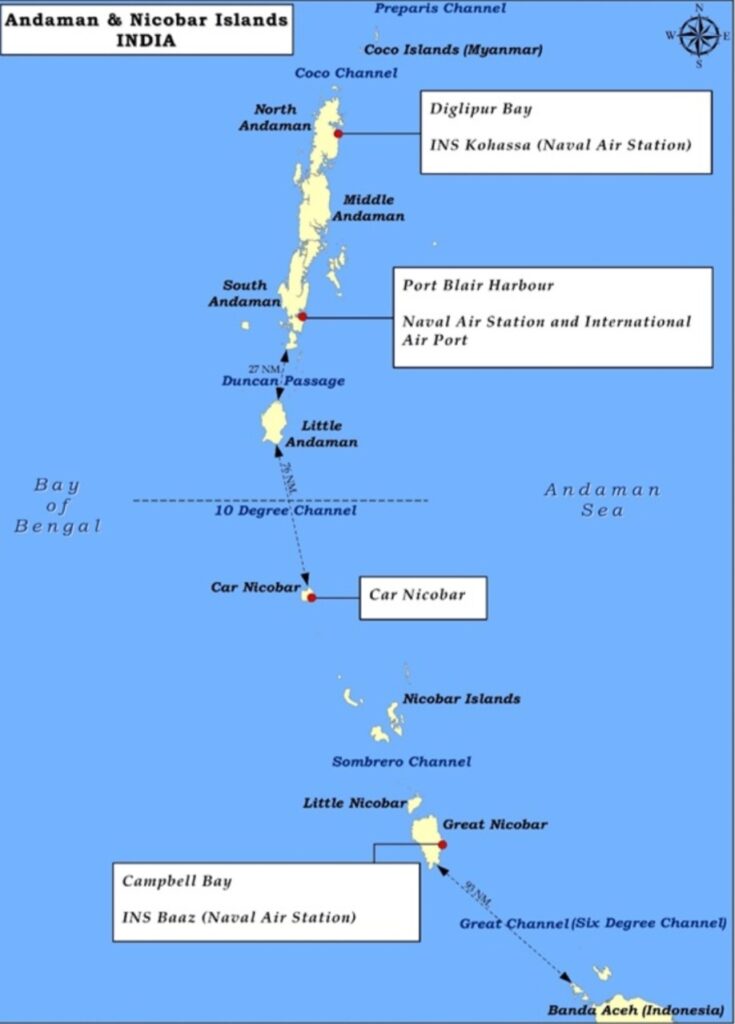By: Sagnik Sarkar

The 572 islands which comprise the Andaman and Nicobar Islands, forming India’s southeastern border, lie in an extremely significant strategic zone. The southernmost tip, known as Indira Point, is just 90 nautical miles from Indonesia, while the northernmost portion of the island is only 22 nautical miles from Myanmar. More than 60,000 commercial vessels pass through the Six Degree and Ten Degree canals, which are dominated by these islands, and the Bay of Bengal every year.
The Malacca Strait and the Six Degree Channel are two of the nine main choke-points that restrict access to this area. Because the Andaman and Nicobar Islands are located in this strategically critical area, India’s expanding naval capabilities may play a significant role in regulating access.
Admiral R. K. Dhowan, the former head of the Indian Navy, had in 2016 recognised that the Andaman and Nicobar Islands serve as a “extended arm” of India and are a “very very vital part” of that nation’s security. According to Dhowan, India must send naval personnel to the islands to keep an eye on vital shipping lanes.
Now, with the growing presence of China in the Indian Ocean region, it is important to have in place a blueprint to challenge this unprecedented rise. Keeping this in mind, the massive Rs 72,000 crore development project on the crucial Great Nicobar Island has recently received environmental clearance from the Ministry of Environment, Forests, and Climate Change. Over the course of the next 30 years, the project will be carried out in three stages. An International Container Transhipment Terminal (ICTT), a greenfield airport, a power plant, and a township for the workers who will carry out the project have all been suggested as part of a “greenfield city.” The NITI Aayog has stated in a report that “the projected port will allow Great Nicobar to engage in the regional and global marine economy by becoming a significant participant in cargo transshipment.”
The Indian Navy will be in charge of the port, while the airport would serve both military and civilian purposes as well as tourists. To accommodate tourists, plans have been made for roads, public transportation, water supply and waste management facilities, as well as a number of hotels. A total of 166.1 sq km have been designated for the project along a coastline strip with a width of between 2 and 4 km along the island’s southern and southeast shores. 9.64 lakh trees are anticipated to be cut down as part of a 130 sq km forest diversion plan. The port is anticipated to be operational by 2027–2028. Development activities are slated to start in the current fiscal year. Over the course of development, the island is anticipated to add 1.5 lakh indirect jobs in addition to more than 1 lakh new direct ones.
The southernmost Island of the Andaman and Nicobar archipelago, Great Nicobar, has a 910 sq km land area. The Great Nicobar Island contains coastal plains, mountain ranges that rise close to 650 metres above sea level, and tropical wet evergreen forests. The island is home to 113 species of fish, 71 species of birds, 10 species of amphibians, 26 species of reptiles, and 14 species of mammals, some of which are endangered. The island’s signature species is the leatherback sea turtle.
Although there is a lot of potential for tourists on the island, the government’s main objective is to take advantage of the island’s advantageous location for both tactical and strategic reasons. Great Nicobar is situated close to the East-West international shipping corridor, along which a sizable portion of the world’s shipping traffic travels, and is equally distant from Colombo to the southwest, Port Klang and Singapore to the southeast. For cargo ships making this trip, the projected ICTT may end up serving as a hub.
Great Nicobar’s development was first proposed in the 1970s, and its significance for bolstering regional stability and national security has been emphasized time and time again. This objective has recently taken on a lot more significance as a result of rising Chinese assertiveness in the Indo-Pacific and Bay of Bengal.
Many environmentalists are, however, concerned about the proposed large infrastructure development in an environmentally significant and vulnerable region, which would include the removal of about a million trees. They have cautioned that by increasing runoff and silt deposits in the water, the loss of tree cover will have an effect on the island’s flora and animals as well as the neighboring coral reefs.
Coral reefs are of crucial ecological value and are already threatened by rising oceans. Environmentalists have also brought up the concern that the construction plan may cause the mangroves on the island to disappear. In the past, India had success moving a coral reef from the Gulf of Mannar to the Gulf of Kutch. The Zoological Survey of India is now calculating how much of the reef will have to be shifted to finish the project. A leatherback turtle conservation strategy, according to the administration, is also in place.
The administration claims that advancing the project is crucial for both national security and strategic reasons. After the first stage of clearance was granted on October 27, officials stated that all factors would be carefully considered before final approval was given.
The project’s location, which is right outside the eco-sensitive areas of Campbell Bay and Galathea National Park, has raised some eyebrows. However, according to the Center, just a small portion of the island and its forest cover is going to be under development, and 15% of that area will be made up of greenery and open areas.
The development of the Great Nicobar Islands is a step in the right direction, with the archipelago now being strongly recognised and considered as a strategic asset. The project is ambitious and once fulfilled will significantly change the picture of the region in vast aspects. However, a lot of other issues should be kept in mind, and measures must be rightfully undertaken to ensure that the ecological concerns be rightfully addressed. Whether relocation of the island’s forests into the Indian mainland is indeed a viable solution remains a matter of debate amongst scholars and policymakers. The decision-makers must also keep in mind the concerns of the local populations and the tribal communities of the region, who will be the ones directly affected by the subsequent massive redevelopment.

About the Author
Sagnik Sarkar is a graduate of Political Science from the Department of International Relations, Jadavpur University. Currently, he is pursuing his Masters in International Relations from the same institution. He is passionate about researching, and has a special interest towards International Relations, Diplomacy, Connectivity, Trade, Human Rights, Conflict Studies, Public Policy and Governance. He has been associated with numerous think tanks in the past, such as CSIRD, Asian Confluence and Asia in Global Affairs. He is extremely enthusiastic about academic writing and has authored and published numerous research papers and articles pertaining to various issues under the realm of Political Science and International Relations for notable organizations.


Thanks for sharing. I read many of your blog posts, cool, your blog is very good.
Thank you for your sharing. I am worried that I lack creative ideas. It is your article that makes me full of hope. Thank you. But, I have a question, can you help me?
Thank you for your sharing. I am worried that I lack creative ideas. It is your article that makes me full of hope. Thank you. But, I have a question, can you help me?
Your article helped me a lot, is there any more related content? Thanks!
Thanks for sharing. I read many of your blog posts, cool, your blog is very good.
Thanks for sharing. I read many of your blog posts, cool, your blog is very good.
Your article helped me a lot, is there any more related content? Thanks!
Your article helped me a lot, is there any more related content? Thanks!
Thank you for your sharing. I am worried that I lack creative ideas. It is your article that makes me full of hope. Thank you. But, I have a question, can you help me?
Your article helped me a lot, is there any more related content? Thanks! https://accounts.binance.com/es/register?ref=T7KCZASX
Thanks for sharing. I read many of your blog posts, cool, your blog is very good.
Thanks for sharing. I read many of your blog posts, cool, your blog is very good.
Your article helped me a lot, is there any more related content? Thanks!
Thank you for your sharing. I am worried that I lack creative ideas. It is your article that makes me full of hope. Thank you. But, I have a question, can you help me?
Your article helped me a lot, is there any more related content? Thanks!